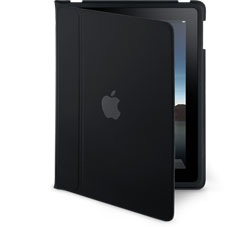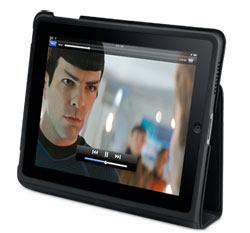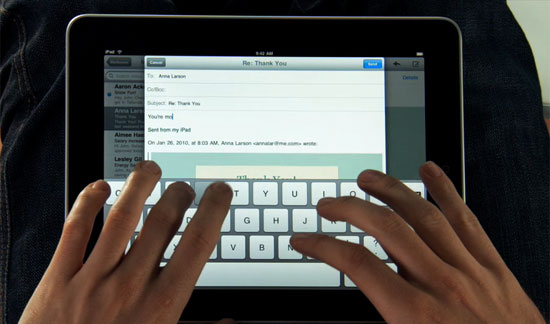The Apple iPad - Anand's Analysis
by Anand Lal Shimpi on January 27, 2010 5:00 PM EST- Posted in
- Smartphones
- Mobile
Will it Work...Literally
Today my issue with the iPhone (and netbooks for that matter) is that they are very limited when it comes to productivity. I don’t have a good solution if I need the performance, usability and capabilities of my notebook, but want something lighter to carry around with me. You could always get a CULV notebook or from Apple something like the MacBook Air, but that’s still a notebook. There is no perfect blend of notebook functionality with smartphone portability. If the iPad can achieve that, at least in the same manner that the iPhone did for smartphones, then I will consider it worth the hype.
Achieving that goal requires a delicate balance of the right UI, the right hardware (including ergonomics) and the right functionality.
The UI looks clean and snappy. Apple’s biggest omission here appears to be multitasking support. One of the most frustrating things about using an iPhone is its inability to do two serious tasks at once. Email + Web browsing, Pandora + anything. You get the point. This is perhaps a temporary issue. The iPad runs iPhone OS 3.2 as of today. The next major release of the iPhone OS, version 4.0, is expected to add multitasking support. This could presumably make its way onto the iPad later this year (or early 2011?).

Yeah that looks super comfortable...
The hardware looks good. It remains to be seen whether or not it’s actually comfortable to hold a 1.5 lbs tablet while you type on it. Although Apple has a couple of accessories that look to address that issue:
 |  |
 |  |
The software keyboard looks like it could work well, if it’s combined with the same sort of predictive trickery that the iPhone uses. I’ve been asking for the sort of tablet the Enterprise crew (Star Trek, not the server market) carried around. The iPad’s interface, at least what I’ve seen of it, has the most potential to deliver that sort of experience. The iPad UI could be something that feels like it was made in 2010, not 2002.

The functionality is also a big unknown. When the iPhone first launched its killer apps were the ones that Apple made for it. While the App Store is far more mature now, the iPad will need some key functionality for it to be a productivity device.
Porting iWork ($9.99 per app) to the iPad was necessary. The fact that Apple did this right off the bat indicates that at least someone over there knows that the market for a $500 - $900 toy is slim. But we need more. We need things like Photoshop for the iPad. Dare I say that we even need a port of Microsoft Office?
At CES everyone talked about tablets and eReaders being huge at the show. I saw a lot of neat devices, but nothing I’d want to go out and buy. The iPad is the first one I’ve seen with potential. And much like the iPhone before it, whether you like it or not is irrelevant - it will at least pave the way for other companies to emulate and improve upon the design.










155 Comments
View All Comments
Mike1111 - Friday, January 29, 2010 - link
Why wouldn't you? It's not like Windows where a higher ppi means smaller text.My problem with exactly 1080p would have been the aspect ratio. 16:9 is not really optimal for a tablet, 3:2 like the iPhone makes imho the most sense (with 16:9 a landscape software keyboard would take up too much screen real estate). 1920x1280 (multiple of iPhone resolution) would have been my personal favorite.
But since it's highly unlikely that Apple will change the resolution or aspect ratio anytime soon (imho not for at least 2 years), we'll have to live with 1024x768 and 4:3 for a while. Maybe if the iPad is a mega huge success Apple will develop an iPad Pro ($800-$1200 instead of $500-$830) for the high-end :)
AstroGuardian - Thursday, January 28, 2010 - link
What about DRM and it's disgusting consequences? Anand?A5 - Thursday, January 28, 2010 - link
If you still want to fight the DRM fight, I'd recommend a time machine to 5 years ago. DRM isn't going anywhere and this device isn't going to do anything worse than devices that are already out there.Sandwiched - Thursday, January 28, 2010 - link
You mentioned that the resolution is disappointing, but if the 1024x768 display is a full 9.7" diagonal, then it works out to 131.959 PPI. Considering that a common print quality is 300 DPI, and most computer monitors are in the 72-100 PPI range, I'd say that 132 PPI is pretty decent for a 9.7" screen.Now, if you'd had issue with the bezel size, I could understand that. Perhaps that will be the iPad 2 - same dimensions, smaller bezel, larger screen. :)
Mike1111 - Friday, January 29, 2010 - link
You sit a lot farther away from a computer monitor than you would from the iPad (more like book or magazine reading distance). And even 300 dpi is pretty low for a high quality magazine.The final goal for a ereader tablet should be to look like national geographics, and not just a little better than your computer monitor.
Around 200 ppi would have been okay for the iPad, 250 ppi or more would have been better (Motorola Droid has 265 ppi).
But yes, the bezel could have been smaller. I find that the bezel of the iPhone (top and bottom) is big enough for most thumbs. Plus content almost never starts immediately at the sides. And modern capacitive sensors and software should be able to differentiate between a hand holding the device and a thumb or finger interacting with the screen. I mean you could even place some capacitive sensors (really low density) in the bezel to detect where the user is holding the device to make it easier.
cjb110 - Thursday, January 28, 2010 - link
The usage model presented seems very very similar to the usage model of ChromeOS. The recent interview in Ars had the dev discussing leaving it on the couch, picking it up, browsing to a site and turning it off again.Now I think most people are assuming Chrome OS is a screen+keyboard netbook/laptop...but if iPad is slightly succesfully, I doubt it would take Google very long to get nice touchable UI in there.
Byte - Thursday, January 28, 2010 - link
Ouch, looks like apple finally hit a flop on this one.wwwcd - Thursday, January 28, 2010 - link
Too expensive for free buy!vrodic - Thursday, January 28, 2010 - link
Anand, why do you assume that A4 is ARM based? Apple has extensive development experience in PowerPC architecture, and PA Semi created PowerPC based designs. It also means that there are no ARM license costs. PowerPC is quite a power efficient architecture.Most of the OS is written in portable C code, and recompiling it to a PowerPC architecture is not a significant effort. Also, existing iPhone 3rd party apps could be recompiled with the new SDK to run on iPad, and only if they use some custom ARM assembler code the "port" would require significant effort.
Mike1111 - Thursday, January 28, 2010 - link
As far as I understand it iPhone apps run without any modifications on the iPad.